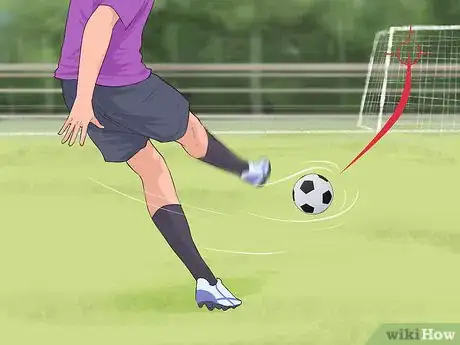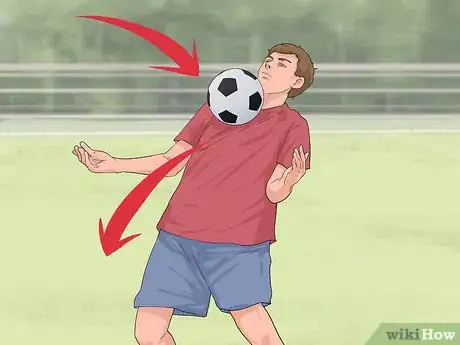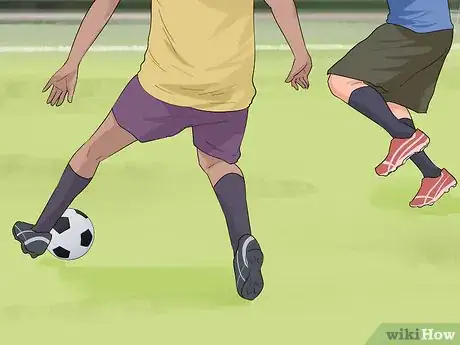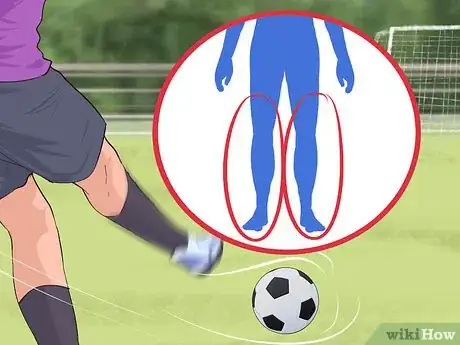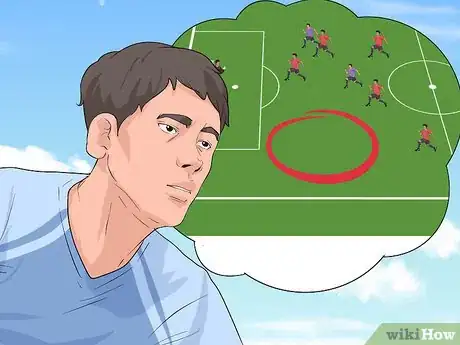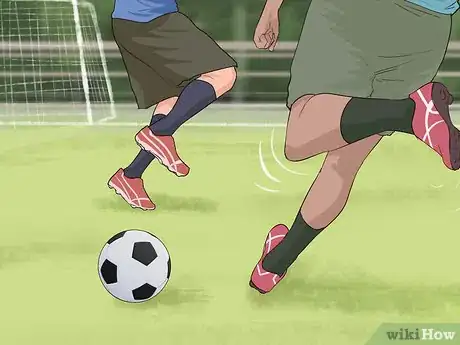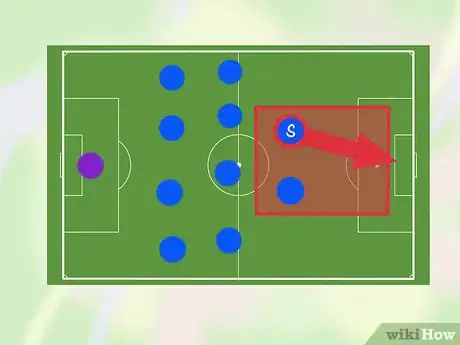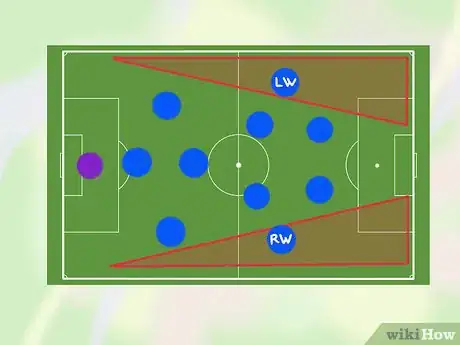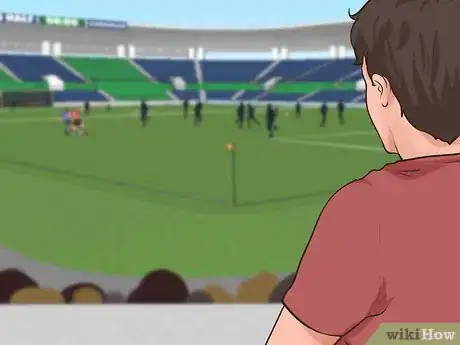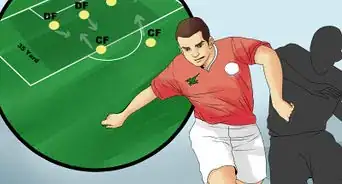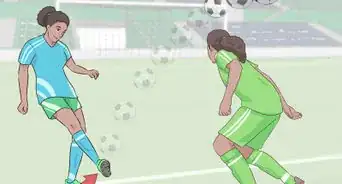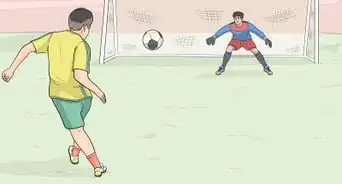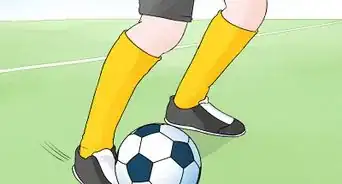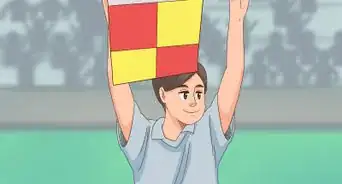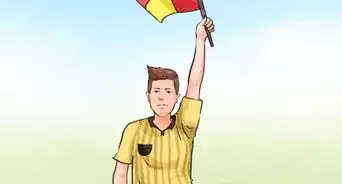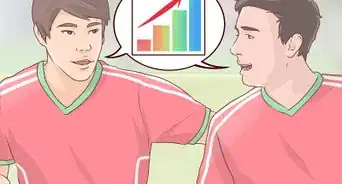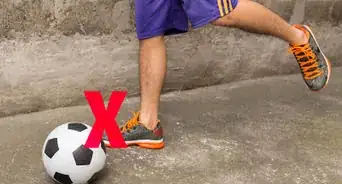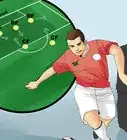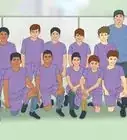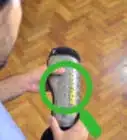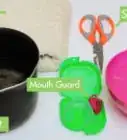This article was co-authored by Walter Merino. Walter Merino is a Youth Soccer Coach and Co-Founder of Ole Soccer Club based out of the Los Angeles, California area. He has coached youth from the age of four to the high school and college levels. Walter has played collegiate soccer for Cal Poly Pomona and Los Angeles Mission College. His accomplishments include coaching Olé Soccer Club to win the 2017 Cal South State Cup Governors Boys 2007 Division title.
There are 7 references cited in this article, which can be found at the bottom of the page.
wikiHow marks an article as reader-approved once it receives enough positive feedback. This article received 17 testimonials and 92% of readers who voted found it helpful, earning it our reader-approved status.
This article has been viewed 543,083 times.
In the game of soccer, forward is an extremely important position. To become a forward, you'll need to have speed, good footwork, a powerful shot, and a cunning soccer mind. While a striker only gets a few chances a game, you'll need to turn them into goals! To be a good soccer striker, start by training for the position. Then, learn how to read the game so you can adjust your play.
Steps
Training Effectively as a Forward
-
1Learn to shoot quickly while still maintaining accuracy.[1] The faster you can pull off a shot, the more deadly you'll be up top. You should work on a two-touch shot. Your first touch creates space to swing your leg, either to the side of a defender or as you receive the ball. The second touch is the shot itself. If you can take these two touch shots, you'll be able to push the ball to the side of a defender and fire off a shot before they can even react.
- Once you feel good on these quick shots, creating space and striking rapidly, work on it on the run, dribbling towards goal, taking a touch, and shooting.[2]
-
2Practice putting the ball on net immediately out of the air. Typically, this is a header on goal or a "volley," which is when you strike the ball before it hits the ground. Difficult but essential, a great forward can redirect an aerial ball towards the goal without settling the ball, which gives the defense time to react. You can practice this easily with a friend hitting your crosses and corner kicks, but keep some things in mind.
- Follow through towards your target. For headers, this means your shoulders will turn to face the goal. For kicks, the indicator is usually your hips, which will turn with the shot to face goal on accurate finishes.
- This skill is almost useless if you're standing still. Always jog, move, or attack the ball on the run, even in practice. It is rare to have time to stand still in a game with the ball approaching the box.
Advertisement -
3Focus on controlling the ball out of the air with your entire body. You will have to be good at controlling the ball from the air, which means bringing the ball from the air to the ground smoothly. This is because a lot of the game for a forward comes from long balls and aerial crosses. You want your touch to end with the ball about a foot in front of you so that your next touch can immediately pass, shoot, or dribble. Good ways to practice include:
- Juggling is a great way to practice full body touch, but only if you challenge yourself. See how high you can get the ball and still maintain control.
- Hit long balls with a friend. Start about 20 yards away, and slowly get further and further. As you get better, pick up the speed between controlling and hitting the ball back.
- Hit against a wall, drilling shots or crosses at a hard surface and reacting quickly to trap the rebound.[3]
-
4Practice challenging defenders one on one.[4] You must be able to get around them without help from teammates.[5] Once you have the ball, you must be able to dribble around the defenders and to the goal by using a variety of "moves" such as the Maradona, the step-over, or the scissors. Some good dribble moves are shoulder feint and step over. Not all forwards need to play silky, technical soccer like Messi, but you need a few ways around a defender to make them step up and respect you instead of hanging back and waiting for you to pass.
- Get a close friend or teammate and challenge them to 1v1 drills. Simply make a thin rectangle and alternate attacking and defending. Crossing the opposite end line with control of the ball is a "goal."
- You don't always get to beat a defender straight up -- sometimes you have to shield and control the ball with your back to goal, too.[6]
- You can work on moves by yourself. Set up a box and work on dribbling, cutting, and throwing moves at full speed, staying inside the box to work on control.
-
5Develop both feet into dangerous weapons of scoring. The infamous Arjen Robben aside, there are few dangerous forwards who can only use one foot. Feeling comfortable on both your left and right foot greatly expands your toolkit, as good defenders will punish you if you only have one side of the field to use. Whenever doing drills, do them with both feet, and spend extra time developing your shooting and passing skills on your "bad" foot. It will never be as good as your dominant foot, but you'll give defenders fits if you can cut to the other direction and make a clean pass with your weak foot.
Reading the Game Offensively
-
1Watch for the shot at all times, staying hungry for a goal. A forward's number-one goal is to put the ball on target. Even if they don't score, shooting on target creates corners, deflections, and rebounds that lead to goals and put defenses under pressure.[7] Your mindset should always be to create the space needed to pull a shoot off for either you or your teammates.
- Note that you want your team to shoot, not just you. Some forwards will get lots of direct chances, others will feed their partner forwards with good chances and take only a few themselves.
-
2Dart, weave, and sprint into open space to create defensive chaos. A mobile striker is the most dangerous. Even if you don't get the ball every time, good forwards know that they need to keep the defense on their toes for 90 minutes, as this is when they make mistakes and reveal the sorts of gaps that create goals. When your team has the ball, look up for the open space and make a run.
- Always be on a light jog, or on the balls of your toes, to get the jump on defenders when space opens up. They'll be looking to close down space as you try to fill it.
- Keep your eye on your other forward(s). Timing runs to weave and criss-cross with them will throw the defense for an enormous loop.[8]
-
3Time your approach to crosses so that you hit them near full speed. If you're simply standing in the box, waiting for the ball to arrive, you're incredibly easy to mark up. Instead, time your runs so that you get to the ball as it is arriving, allowing you to cut it out before the ball reaches a defender and get a running start for any jumping header. Keep your eye on the ball and reach it just as it becomes available to play and you'll win many more headers, volleys, and long balls.
- This is also the best strategy to avoid offside traps, letting you go from jogging to sprinting once the ball is played instead of trying to hit full speed from standing.
- Curling runs are great for making time and space. Instead of sprinting into the box straight on, take a curving path as the ball is coming down the wings, then cut straight in once the ball is in the air. Your curling run lets you approach the box on the run while still letting you change directions quickly.
-
4Check to the ball instead of always running away from it. Checking means running towards the teammate with the ball, opening up space and making the pass shorter. This is particularly important when working with another striker, as the space you just ran away from is now open for him if your defender follows your check. If you don't get the ball and a defender is on you still, keep moving. If you do get the ball, try to turn to face the goal -- greatly pressuring the defense.[9]
- Always look over your shoulder quickly as you check. If you caught your defender sleeping you may have more time with the ball than you think.[10]
-
5Challenge the defense one on one when you have space to run. A striker can't be selfish, but they also can't be passive. You need to be able to run at a defender with the ball, throwing a move to beat him, sprinting around with a big touch, or sucking in the defense to make a last-second pass. Great forwards force the defense to react to them, which creates space for the rest of your team. The best times to attack are when you have the defense in motion, particularly as they track backward. Go at them, forcing them to make a decision.[11]
- The wings are a good place to really challenge defenders. They usually have little support, and a turnover is much easier to win back with the sideline to your advantage.
- Don't take on defenders if you're near the half-field unless you're sure you can beat them -- a turnover here is particularly dangerous.
- Even if you lose the ball, no defender wants to be under pressure all game. They will start to break down and make mistakes. It only takes a 1 goal difference to win or lose a game, and you want that goal to be in your favor!
-
6Follow all shots and crosses into the goal. This is especially important for younger players, as inexperienced defenders and goalies will make mistakes that lead to easy goals. When you or a teammate shoots, run after the ball towards goal, ready to quickly re-shoot any rebounds, deflections, or partial saves.
- It is very, very difficult to clear the ball on defense when facing your own goal. Make this job even harder and you'll pick up a few easy goals a season.[12]
-
7Come back to the midfield on defense, holding up the back defenders. Wait to receive the ball off a clearance or a punt. You're no good to your team on defense or offense if you just sit up top and wait. Come back to midfield to keep the defenders from settling the ball and playing easy crosses in without pressure. Most importantly, be ready to check or sprint on counter-attacks. If the ball is being crossed or cleared, it is your job to hold onto possession until your team gets into offensive position.[13]
Adjusting Your Play Based on Forward Positioning
-
1Tweak your strategy and runs depending on your team's offensive system. Not all forwards can play with the same style. The biggest variable is how many other strikers you're playing with, as this greatly changes how you handle yourself. If you're the only one up top, you're going to want to stay high up on the defense, spreading the field for your team. If there are three strikers, you're necessarily going to have to come back on defense at times.
- The high forward, used to hold onto the middle of the field and create space, is often called a center forward. They are big targets who hold up the ball and create offensive space for others.
- Wing forwards, or wingers are basically offensive outside midfielders. They must be excellent one-on-one dribblers with great speed and crossing ability.
- Strikers often hold underneath a center forward who controls the ball with his/her back to goal. Their goal is to get the ball to a striker in a dangerous position, making the striker your fastest ball-handler and shooter.
-
2Hold the space up field as far as the defense will allow. As the center striker, you need to create space for the rest of the team, so hold the off-sides line as deep as the defense will let you. When you get the ball, try to turn to face the goal, but know that this isn't necessary; you simply want to hold the ball as your teammates sprint up to support you. Your goal is to suck the defense in, forcing them to play you so that they open up oodles of space along the wings.
- If there are two center strikers, try staggering yourselves with one up higher and one sitting closer to the midfield. This opens up space for both of you to each sideline, as well as for dangerous combination play in the middle.
-
3Control and direct the middle of the field quickly and efficiently. As a striker, you need to be looking for shots. Whether as part of a 2-person or 3-person system, striking forwards want to get the ball facing the goal whenever possible. Strikers are trying to create just enough space to get a shot off, punishing the defense for lapses and laziness. Your bread and butter is going to be quick, one-touch passes and one-two combinations, or throwing a quick scissors and ripping a shot with space. Don't stand around with the ball -- keep it moving and always look for shots, making 10-20 yard sprints through the defense for quick, slotted passes and shots.
- Shooting, even when you don't score, is useful. As defenses feel shots coming from further out, they will push up to prevent you from shooting more often. This often opens up space behind them for through passes and crosses.[14]
-
4Focus on quality crosses and dangerous diagonal runs in the winger position. Attack the end line ruthlessly, driving down at defenders and forcing them to make tackles that lead to corners and deep throw-ins. Your goal is to get the ball down near the end line and then put it into the box, preferably as the defenders are running towards their own goal. Furthermore, keep your eye on the middle of the field. If the center defenders are getting lazy or seem to forget about you, a sharp diagonal run straight at goal will open you up for crosses, through balls, and shots.
- As soon as your team wins the ball, get out as wide as possible. This will stretch the defense considerably, making tons of space for you and others.
- Depending on the team formation, a winger may be expected to play a lot more defense than most forwards. Be sure to coordinate this with your coach and outside backs.[15]
-
5Watch professional forwards. Notice what they do without the ball. Next time you watch a professional game, pay attention to where the forward is when they're not touching the ball. Note how good forwards are always moving, which makes the defense constantly look up and readjust. As you watch more, pay attention to how the two or three forwards work together, holding their space and crisscrossing to manipulate the defenders into creating space.
- Watch both teams' strikers. How does their movement differ?
- What do the strikers do in different parts of the game? If a team is winning, they tend to sit back, whereas losing teams like to push strikers up further to create goal-scoring opportunities.
Community Q&A
-
QuestionWhat are some drills to get faster?
 Community AnswerRunning hard up a hill is a good way to improve leg strength and speed. Combine that with strength training in the gym (squats, leg press, etc.).
Community AnswerRunning hard up a hill is a good way to improve leg strength and speed. Combine that with strength training in the gym (squats, leg press, etc.). -
QuestionWhat should I eat?
 Community AnswerIt's all about balance. Eat a healthy diet with lots of fruits, lean meats, veggies, and whole grains. Minimize the junk food.
Community AnswerIt's all about balance. Eat a healthy diet with lots of fruits, lean meats, veggies, and whole grains. Minimize the junk food. -
QuestionCan you list the basic natural abilities that help to become winger or striker?
 Community AnswerTo be a winger or a striker you need ideally: Pace, good shot/cross, control, strength, positioning and instincts as to where the ball will go and when to make a run. Even if you don't have these attributes, you can always get better through practice and some things like pace are not essential but just ideal.
Community AnswerTo be a winger or a striker you need ideally: Pace, good shot/cross, control, strength, positioning and instincts as to where the ball will go and when to make a run. Even if you don't have these attributes, you can always get better through practice and some things like pace are not essential but just ideal.
References
- ↑ Walter Merino. Soccer Coach. Expert Interview. 29 January 2020.
- ↑ http://www.completesoccerguide.com/soccer-forward/
- ↑ http://www.completesoccerguide.com/soccer-forward/
- ↑ Walter Merino. Soccer Coach. Expert Interview. 29 January 2020.
- ↑ Walter Merino. Soccer Coach. Expert Interview. 29 January 2020.
- ↑ http://www.completesoccerguide.com/soccer-forward/
- ↑ Walter Merino. Soccer Coach. Expert Interview. 29 January 2020.
- ↑ http://www.completesoccerguide.com/soccer-forward/
- ↑ Walter Merino. Soccer Coach. Expert Interview. 29 January 2020.
- ↑ http://www.teachpe.com/soccer_football/striker.php
- ↑ http://www.completesoccerguide.com/soccer-forward/
- ↑ http://ussoccerplayers.com/2009/10/responsibilities-of-a-forward.html
- ↑ http://ussoccerplayers.com/2009/10/responsibilities-of-a-forward.html
- ↑ http://www.onlinesocceracademy.com/soccer-training-videos/attacking/how-to-play-forward/
- ↑ http://www.teachpe.com/soccer_football/striker.php
About This Article
Being a good soccer striker is all about learning to react quickly, controlling the ball, and keeping an eye out for any opportunity to shoot. You won’t have much time to think before taking a shot, so practice shooting quickly when you get the ball. You should also practice volleying the ball, since the perfect opportunity to shoot might come while the ball is in the air. Master taking shots with both feet, which will help you a lot if you don’t have time to switch your stance. Another thing to practice is your foot technique when getting past single defenders, which is an important skill to have when you’re running for the box. If you shoot and the ball deflects back, always be ready for a second shot, since many keepers won’t be prepared for it. For more tips, including how to practice offensive tactics for a soccer match, read on!
